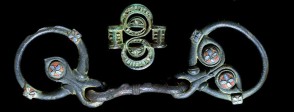A good starter activity would be to investigate the pieces of harness and then link them to the Wetwang burial. Familiarise yourself with the pieces first by following the links in About the object and by looking at the other resources in For the classroom, including the BBC animation.
Show the students the image of the pieces of harness in For the classroom. Ask them if they can work out what they are. Discuss the decoration and patterns and what this tells us about the owner. Identify the pieces by name. Use the BBC animation and the photo of the strap union in For the classroom to show how the pieces were used and whereabouts they went.
Look at the diagram of the Wetwang grave in For the classroom. Encourage students to spot the objects whose names they have learned and where they were found in the grave. Help them to work out that although the chariot and yoke have vanished, the positions of the pieces of harness show where they were originally. They could try creating their own archaeological report, transforming the visual information of the diagram into a verbal report.
Split the class into groups and tell each group they are going to be given a different interpretation of who the woman was and why she was buried with a chariot. They should build an argument using the evidence to support their story and present it back to the class. Here are some interpretations:
- she was a warrior woman who went into battle on her chariot
- she was a queen who had a ceremonial chariot
- her husband had a chariot made for her to be buried with when she died to show how rich he was
- she had gone on a journey and died while away and was brought back in a chariot that was buried with her
After all the presentations the class should evaluate which interpretation seems the most likely. Do the students have other possible interpretations?
Explain to students that not all Iron Age objects have been found in graves. Look at the other Iron Age objects in A bigger picture. In what other ways were these objects deposited? Can students think of reasons why these particular types of objects may have been deposited? Why do they think some were buried and some put in water? Do they have any suggestions for what these deposits may tell us about the beliefs of Iron Age people?
Explore the use of coral for inlay on the chariot trappings and the woman’s brooch from Wetwang. Where does coral come from? Where is the closest place to Britain you can find it? How might it have got to East Yorkshire? What does it tell us about links between Britain and the wider world? What does it tell us about the woman buried in Wetwang?
Here are two enquiries you might use. The first one would link well if you are also studying Roman Britain.
Could women be powerful in the Iron Age?
A burial such as Wetwang could prompt questions about women rulers. Do some research on Queen Boudica. Was she a typical Iron Age woman or were there special circumstances about her life? Look at photos of her statue near Westminster Bridge in London. Boudica is often shown as a warrior queen in a chariot. Does the Wetwang burial affect that interpretation of her? Can people eonly be powerful by being a ruler? Why do students think Boudica has become such a famous character even though she lost to the Romans?
What was important to people in Iron Age Britain?
Print out images of all the objects in this Object File and ask the students to compare them with each other looking at function, value, decorative style. Based on these objects what do they think mattered in the Iron Age and to whom? You could then contrast with the objects in Object File: A mace-head from near Stonehenge (coming soon).


